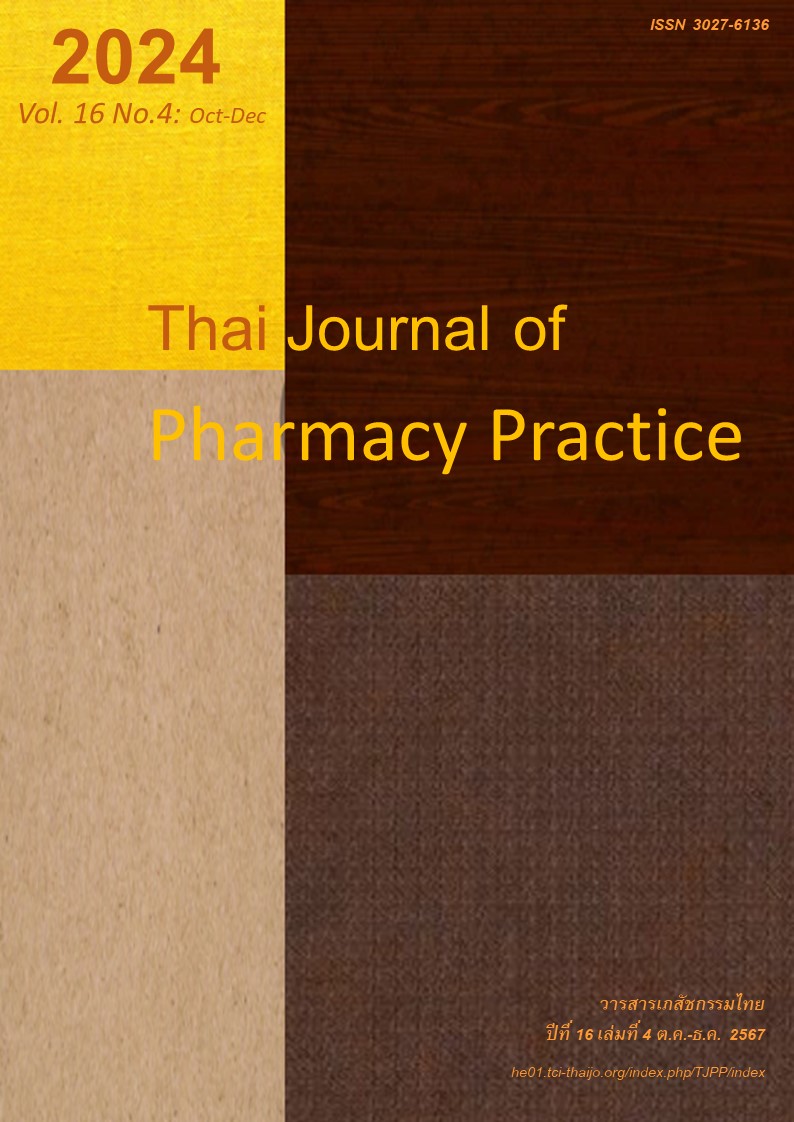ผลจากการรักษาเสริมของยากลุ่ม Sodium-Glucose Cotransporter 2 Inhibitors ต่อ อัตราการกรองของไตในผู้ป่วยโรคเบาหวานชนิดที่ 2 ที่ได้รับยาต้านระบบ Renin-Angiotensin
Main Article Content
บทคัดย่อ
วัตถุประสงค์: เพื่อเปรียบเทียบการเปลี่ยนแปลงอัตราการกรองของไต (estimated glomerular filtration rate, eGFR) ในผู้ป่วยโรคเบาหวานชนิดที่ 2 ที่ได้รับการรักษาเสริมด้วยยากลุ่ม sodium-glucose cotransporter 2 inhibitors (SGLT2 inhibitors) ร่วมกับยาต้านระบบ renin-angiotensin (RAS blockers) เทียบกับกลุ่มที่ได้รับ RAS blockers วิธีการ: งานวิจัยนี้เก็บข้อมูลย้อนหลังจากเวชระเบียนอิเล็กทรอนิกส์ในโรงพยาบาลสวรรค์ประชารักษ์ การศึกษาคัดเลือกผู้ป่วยโรคเบาหวานชนิดที่ 2 อายุ 18 ปีขึ้นไป ระยะเวลาตั้งแต่มกราคม พ.ศ. 2560 ถึงธันวาคม พ.ศ. 2564 เข้างานวิจัยจำนวน 350 ราย กลุ่มศึกษา คือ กลุ่มที่ได้รับยากลุ่ม SGLT2 inhibitors ร่วมกับ RAS blockers 175 ราย กลุ่มควบคุม คือ กลุ่มที่ได้รับยากลุ่ม RAS blockers 175 ราย ผลลัพธ์ของการศึกษา คือ ค่าอัตราการกรองของไต น้ำตาลสะสมฮีโมโกลบิน ความดันโลหิต และน้ำหนักตัวซึ่งวัด ณ เดือนที่ 0, 3, 6 และ 12 ผลการวิจัย: อัตราการกรองของไตระหว่างกลุ่มศึกษาและกลุ่มควบคุมทั้งในเพศหญิงและเพศชายไม่แตกต่างกันอย่างมีนัยสำคัญทางสถิติ โดยมีเพศหญิงเป็นปัจจัยที่มีผลต่อการเปลี่ยนแปลงอัตราการกรองของไตที่ P=0.024 น้ำตาลสะสมฮีโมโกลบินของทั้ง 2 กลุ่มไม่แตกต่างกันอย่างมีนัยสำคัญทางสถิติ โดยมีระยะเวลาการเกิดโรคเบาหวานและค่าน้ำตาลสะสมฮีโมโกลบินพื้นฐานเป็นปัจจัยที่มีผลต่อการเปลี่ยนแปลงค่าน้ำตาลสะสมฮีโมโกลบินที่ P=0.003 และ P<0.001 ตามลำดับ น้ำหนักตัวของทั้ง 2 กลุ่มแตกต่างกันอย่างมีนัยสำคัญทางสถิติที่ P=0.008 โดยมีความแตกต่างของค่าเฉลี่ยน้ำหนักตัวต่อปีในกลุ่มศึกษาและกลุ่มควบคุมเท่ากับ -1.62 และ -0.35 กิโลกรัม ตามลำดับ น้ำหนักตัวพื้นฐานเป็นปัจจัยที่มีผลต่อการเปลี่ยนแปลงน้ำหนักตัวที่ P<0.001 สรุป: ผู้ป่วยโรคเบาหวานชนิดที่ 2 ที่ได้รับยากลุ่ม SGLT2 inhibitors ร่วมกับ RAS blockers ช่วยลดน้ำหนักตัวได้มากกว่ากลุ่มที่ได้รับยา RAS blockers
Article Details

อนุญาตภายใต้เงื่อนไข Creative Commons Attribution-NonCommercial-NoDerivatives 4.0 International License.
ผลการวิจัยและความคิดเห็นที่ปรากฏในบทความถือเป็นความคิดเห็นและอยู่ในความรับผิดชอบของผู้นิพนธ์ มิใช่ความเห็นหรือความรับผิดชอบของกองบรรณาธิการ หรือคณะเภสัชศาสตร์ มหาวิทยาลัยสงขลานครินทร์ ทั้งนี้ไม่รวมความผิดพลาดอันเกิดจากการพิมพ์ บทความที่ได้รับการเผยแพร่โดยวารสารเภสัชกรรมไทยถือเป็นสิทธิ์ของวารสารฯ
เอกสารอ้างอิง
Aekplakorn W, Puckcharern H, Satheannoppakao W. The 6th survey of Thai public health by physical examination 2019-2020. Bangkok: Graphic and design publishing; 2021. p.177-87.
American Diabetes Association Professional Practice Committee; 4. Comprehensive medical evaluation and assessment of comorbidities: standards of medical care in diabetes-2022. Diabetes Care. 2021; 45(suppl 1): S46-S59. doi.org/10.2337/dc22-S004.
Zheng Y, Ley SH, Hu FB. Global aetiology and epide- miology of type 2 diabetes mellitus and its complica- tions. Nat Rev Endocrinol. 2018; 14: 88-98. doi:10.1038/nrendo.2017.151.
Ling W, Huang Y, Huang YM, Fan RR, Sui Y, Zhao HL. Global trend of diabetes mortality attributed to vascular complications, 2000-2016. Cardiovasc Diabetol 2020; 19:182. doi:10.1186/s12933-020-01159-5.
van Dieren S, Beulens JW, van der Schouw YT, Grobbee DE, Neal B. The global burden of diabetes and its complications: an emerging pandemic. Eur J Cardiovasc Prev Rehabil 2010; 17 Suppl 1: S3-S8. doi:10.1097/01.hjr.0000368191.86614.5a.
Centers for Disease Control and Prevention. Diabetes and chronic kidney disease [online]. 2021[cited Jul 15, 2022]. Available from: www.cdc.gov/diabetes/ma naging/diabetes-kidney-disease.html.
Adler AI, Stevens RJ, Manley SE, Bilous RW, Cull CA, Holman RR; UKPDS GROUP. Development and progression of nephropathy in type 2 diabetes: the United Kingdom Prospective Diabetes Study (UKPDS 64). Kidney Int 2003; 63: 225-32. doi:10.10 46/j.1523-1755.2003.00712.x.
Kidney Disease: Improving Global Outcomes (KDIGO) Diabetes Work Group. KDIGO 2020 clinical practice guideline for diabetes management in chronic kidney disease. Kidney Int 2020; 98(4S): S1-S115. doi:10.1016/j.kint.2020.06.019.
Wanner Ch, Inzucchi SE, Zinman B. Empagliflozin and progression of kidney disease in type 2 diabetes. N Engl J Med 2016; 375: 1801-2. doi:10.10 56/NEJMc1611290
Neal B, Perkovic V, Mahaffey KW, de Zeeuw D, Fulcher G, Erondu N, et al. Canagliflozin and cardio vascular and renal events in type 2 diabetes. N Engl J Med 2017; 377: 644-57. doi:10.1056/NEJMoa1611 925
Wiviott SD, Raz I, Bonaca MP, Mosenzon O, Kato ET, Cahn A, et al. Dapagliflozin and cardiovascular outcomes in type 2 diabetes. N Engl J Med 2019; 380: 347-57. doi:10.1056/NEJMoa1812389
Perkovic V, Jardine MJ, Neal B, Bompoint S, Heers pink HJL, Charytan DM, et al. Canagliflozin and renal outcomes in type 2 diabetes and nephropathy. N Engl J Med 2019; 380: 2295-306. doi:10.1056/NEJM oa1811744
Neuen BL, Young T, Heerspink HJL, Neal B, Perko- vic V, Billot L, et al. SGLT2 inhibitors for the prevention of kidney failure in patients with type 2 diabetes: a systematic review and meta-analysis. Lancet Diabetes Endocrinol. 2019; 7: 845-54. doi:10. 1016/S2213-8587(19)30256-6
Weber MA, Mansfield TA, Alessi F, Iqbal N, Parikh S, Ptaszynska A. Effects of dapagliflozin on blood pressure in hypertensive diabetic patients on renin-angiotensin system blockade. Blood Press 2016; 25: 93-103. doi:10.3109/08037051.2015.1116258
Weber MA, Mansfield TA, Cain VA, Iqbal N, Parikh S, Ptaszynska A. Blood pressure and glycaemic effects of dapagliflozin versus placebo in patients with type 2 diabetes on combination antihypertensive therapy: a randomised, double-blind, placebo-controlled, phase 3 study. Lancet Diabetes Endocri nol 2016; 4: 211-20. doi:10.1016/S2213-8587(15)00 417-9
Heerspink HJ, Johnsson E, Gause-Nilsson I, Cain VA, Sjöström CD. Dapagliflozin reduces albuminuria in patients with diabetes and hypertension receiving renin-angiotensin blockers. Diabetes Obes Metab. 2016; 18: 590-7. doi:10.1111/dom.12654
Sha S, Polidori D, Heise T, Natarajan J, Farrell K, Wang SS, et al. Effect of the sodium glucose co-transporter 2 inhibitor canagliflozin on plasma volume in patients with type 2 diabetes mellitus. Diabetes Obes Metab 2014; 16: 1087-95. doi:10.11 11/dom.12322
Thewjitcharoen Y, Yenseung N, Malidaeng A, Naka satien S, Chotwanvirat P, Krittiyawong S, et al. Effectiveness of long-term treatment with SGLT2 inhibitors: real-world evidence from a specialized diabetes center. Diabetol Metab Syndr. 2017; 9: 96. doi:10.1186/s13098-017-0297-y
Liu AYL, Low S, Yeoh E, Lim EK, Renaud CJ, Teoh STY, et al. A real-world study on SGLT2 inhibitors and diabetic kidney disease progression. Clin Kidney J 2022; 15: 1403-14. doi:10.1093/ckj/sfac044
Nagasu H, Yano Y, Kanegae H, et al. Kidney outcomes associated with SGLT2 inhibitors versus other glucose-lowering drugs in real-world clinical practice: the Japan chronic kidney disease database. Diabetes Care 2021; 44: 2542–51. doi.org/10.2337/dc21-1081.


